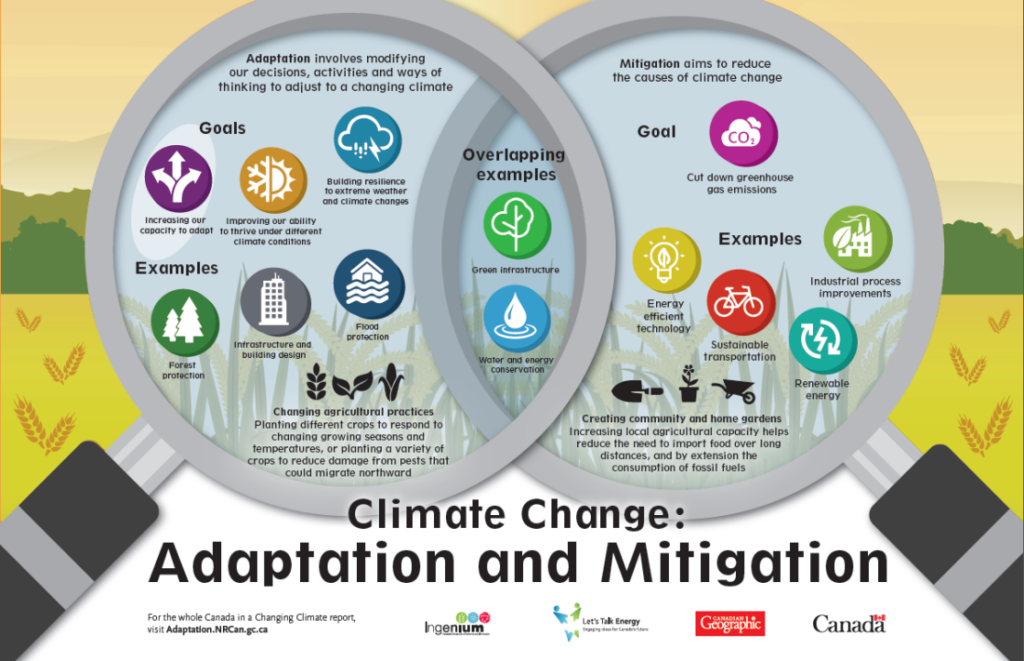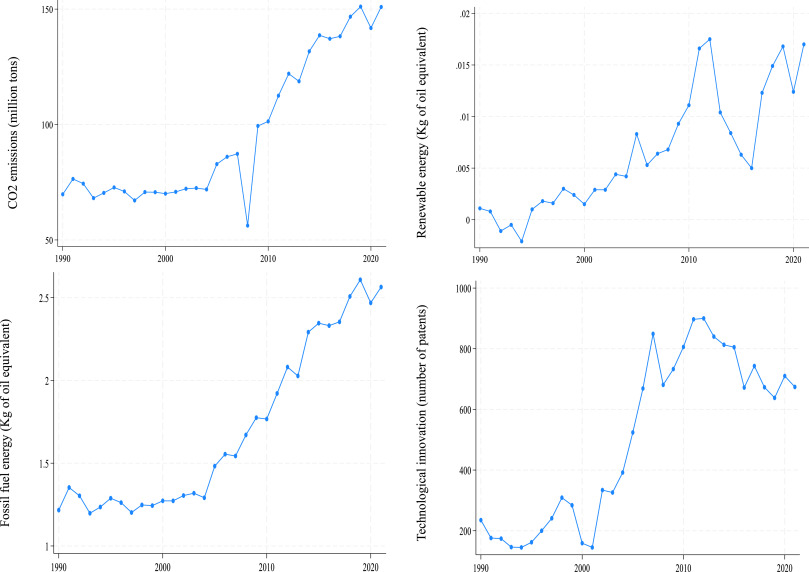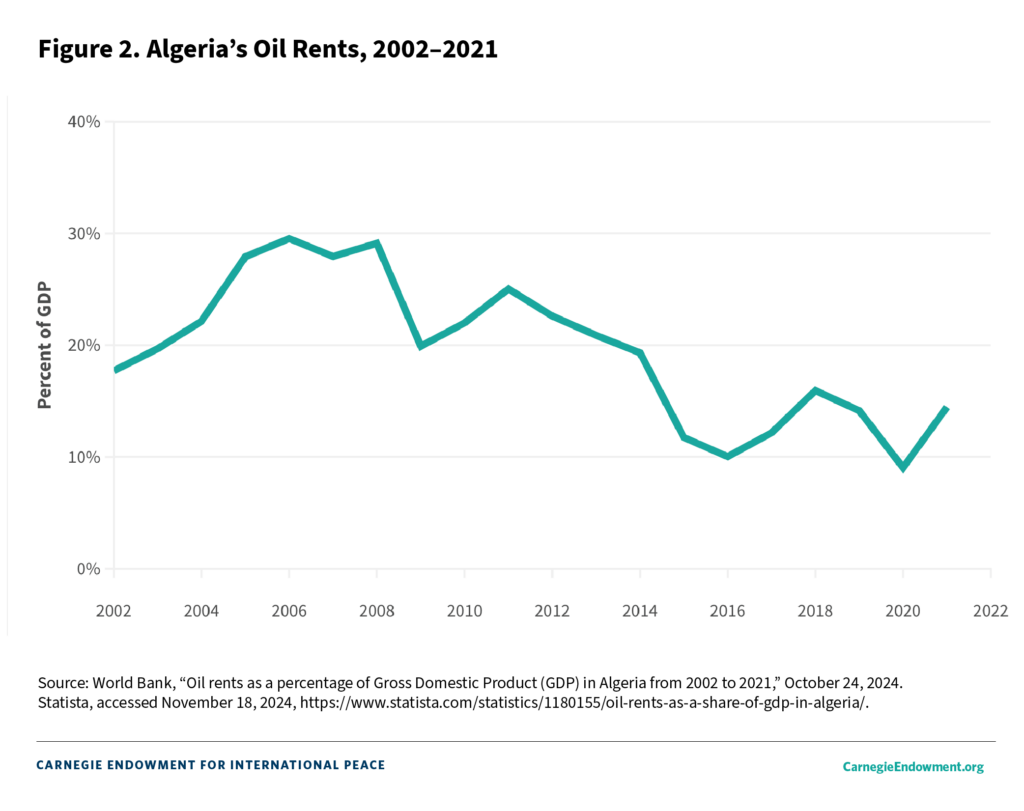Algeria’s geographic and climatic diversity make it highly vulnerable to climate change. Situated within the Mediterranean basin—a recognized climate change “hot spot”—the country faces increasing environmental risks that demand urgent action. In response, the Algerian government has developed climate policies centered on both mitigation and adaptation.

These strategies are primarily guided by Algeria’s Intended Nationally Determined Contribution (INDC) and National Climate Plan (PNC), which provide a framework for addressing climate-related risks across key sectors. However, despite these efforts, Algeria faces significant challenges, particularly in securing adequate funding for its renewable energy transition and strengthening sector-specific policies. Additionally, the country struggles to define clear short- and long-term climate targets and lacks comprehensive, coordinated policies at the national level to drive meaningful progress.
Mitigation and Adaptation strategy
Algeria’s major vulnerabilities to climate change are most evident in the areas of water and agriculture. The country has a semi-arid to arid climate from north to south, making water scarcity a critical concern. With per capita water availability at just 600 m³ per year, Algeria falls well below the United Nations Development Programme’s (UNDP) water shortage threshold and the World Bank’s water scarcity benchmark of 1,000 m³ per capita per year.
Despite having 71 dams with a total capacity of 7.1 billion m³, Algeria has nearly exhausted its mobilizable water potential. Groundwater exploitation in the northern regions has reached approximately 90%, amounting to nearly 2 billion m³ per year, with some aquifers already being overexploited. To meet growing water consumption demands, Algeria has increasingly relied on seawater desalination in recent years, with a production capacity of approximately 2 million m³ per day. (1)
As a result, the national strategy for combating climate change focuses on both mitigation—reducing greenhouse gas emissions—and adaptation—building resilience to environmental shifts. The country’s climate governance strategy has evolved to strengthen regulatory frameworks, enhance stakeholder participation, and promote transparency in decision-making. However, challenges remain, particularly in defining clear short- and long-term climate targets and developing comprehensive sector-specific policies to drive meaningful progress.
Although Algeria had been engaged in climate action before the Paris Agreement, its INDC and National Climate Plan (PNC) now provide the foundation for its mitigation and adaptation strategies. Key adaptation goals include strengthening ecosystem resilience to mitigate climate-related natural disasters, combating land degradation, desertification, and soil erosion, and integrating climate strategies into vulnerable economic sectors such as agriculture, water management, public health, and transportation.
Algeria’s National Climate Plan:
The Algerian National Climate Plan (PNC) serves as a comprehensive framework for both mitigating climate change and adapting to its impacts. Its primary objectives are to achieve sustained socioeconomic growth, foster inclusive social development, and integrate climate adaptation strategies into key economic sectors vulnerable to environmental shifts.
Mitigation efforts focus on reducing greenhouse gas emissions while maintaining economic stability. Algeria aims to diversify its energy sources by expanding renewable energy, improving energy efficiency, and implementing sustainable land-use practices. By investing in clean energy and reducing reliance on fossil fuels, the country seeks to balance economic growth with environmental sustainability.
Adaptation measures are crucial for protecting sectors most affected by climate change, such as agriculture, water resources, and infrastructure. The PNC emphasizes sustainable water management, soil conservation, and resilient urban planning to minimize climate-related risks. Additionally, Algeria promotes social inclusion by integrating local communities into climate action and ensuring that vulnerable populations benefit from adaptation strategies.
Through a combination of policy reforms, financial investments, and international cooperation, Algeria’s National Climate Plan aims to build a resilient economy while addressing environmental challenges. A well-implemented strategy will ensure long-term sustainability and strengthen Algeria’s role in global climate action. (2)
Institutional and Governance Measures
To achieve its adaptation goals, various government institutions and international partners, such as the UN Development Programme, have identified key governance steps:
- Enhancing institutional capacity and cross-sectoral coordination.
- Establishing a centralized climate data system to support evidence-based policymaking.
- Mobilizing private-sector investments to strengthen climate resilience efforts.
In 2018, the Algerian government launched its National Adaptation Planning (NAP) process to integrate adaptation measures into existing plans and sectoral development strategies. This initiative aligns Algeria’s adaptation planning with the National Strategy for the Environment and Sustainable Development (2020–2035), the National Action Plan for the Environment and Sustainable Development (PNAEDD), and the National Climate Plan (PNC). The project aims to overcome institutional, informational, and capacity-related barriers by embedding adaptation into policy frameworks, strengthening institutional and human capacities, and increasing adaptation investments to enhance resilience and reduce vulnerability. (3)
Additionally, Algeria’s adaptation strategies focus on key sectors, including energy, forestry, waste management, and public awareness. In the energy sector, the country has pledged to generate at least 27% of its electricity from renewable sources by 2030. Efforts to improve energy efficiency include better lighting, enhanced thermal insulation, and increased use of liquefied petroleum gas and natural gas. In forestry, reforestation is prioritized as a carbon capture measure. The waste management sector is set for reforms aimed at reducing methane emissions and pollution. Furthermore, Algeria plans to implement a national education strategy to raise awareness of climate change and its impacts. (4)

CO2 emissions, technological innovation, fossil fuel energy, and renewable energy, trends in Algeria
Greenhouse Gas Emissions Reduction Goals
As one of Africa’s three largest energy consumers and CO₂ emitters, Algeria faces the challenge of balancing emissions reduction with the growing energy demands of its population. Over the past three decades, the country has witnessed a sharp rise in CO₂ emissions, more than doubling from approximately 65.35 million tons in 1990 to 139.67 million tons in 2021.
Recognizing the detrimental impact of CO₂ emissions on biodiversity and human well-being, Algeria has acknowledged the urgent need for mitigation. Rising emissions have contributed to severe consequences, including health problems, intensified storms, prolonged droughts, devastating floods, accelerating desertification, and widespread land degradation. Addressing these challenges requires a strategic transition toward sustainable energy sources and the implementation of stronger environmental policies to curb emissions while maintaining economic and social stability. (5)
To combat environmental degradation, Algeria has actively engaged with global climate frameworks. It demonstrated its commitment to international climate cooperation by adhering to the Kyoto Protocol in 2005 and participating in the Paris Agreement. Additionally, government-led initiatives such as the Great Green Dam project, pastoral rehabilitation programs, and substantial financial investments in renewable energy reflect both political will and resource allocation for climate action. Furthermore, Algeria’s National Climate Plan (PNC) sets ambitious emissions reduction targets—7% through national efforts and 22% with international support by 2030.
Achieving these targets requires coordinated efforts across seven key ministries, including the Ministry of Environment and Renewable Energy, the Ministry of Agriculture and Rural Development, and the Ministry of Water Resources and Environment. However, transparency challenges hinder progress. Many ministries, particularly those overseeing energy and transport, lack publicly accessible regulations, limiting access to critical policy information. This lack of transparency impedes coordination between government agencies and restricts engagement with civil society groups and private-sector stakeholders, ultimately slowing progress toward Algeria’s climate objectives. (6)
Budgeting for Climate Resilience
Algeria’s financial commitment to climate action has grown over the years, but investment in renewable energy remains insufficient. From 2016 to 2024, the government increased its climate-related budget allocations, incorporating four main categories: renewable energy, environmental protection, water security, and climate resilience. Water security receives the largest share of the budget, reflecting Algeria’s vulnerability to water shortages. However, funding for renewable energy remains disproportionately low. In 2024, only 0.09% of the national budget was allocated to renewable energy, a figure that may undermine the country’s goal of generating 27% of its electricity from clean sources by 2030.
This underfunding is particularly concerning given that, as of 2022, only 0.7% of Algeria’s electricity came from renewable sources. The Algerian economy remains highly dependent on fossil fuels, which contribute 19% of GDP, 93% of exports, and 38% of government revenue. With global energy policies shifting toward decarbonization, Algeria must improve its financial and institutional support for renewable energy to remain competitive. (7)
Algeria’s Nationally Determined Contributions: A Path to Sustainable Energy
Algeria’s Nationally Determined Contributions (NDCs) reflect the country’s commitment to transitioning toward a more sustainable energy future. By 2030, Algeria aims to reduce its electricity consumption by 9% and increase the share of renewable energy in electricity production to 27%, a significant leap from the current 1%. These targets align with global climate objectives and highlight Algeria’s efforts to balance economic growth with environmental sustainability.
Reducing electricity consumption by 9% requires comprehensive energy efficiency measures. The Algerian government has introduced initiatives such as improved insulation in buildings, modernization of industrial processes, and the promotion of energy-saving appliances. Additionally, raising public awareness about energy conservation is essential to achieving this goal. By prioritizing efficiency, Algeria can reduce reliance on fossil fuels, lower greenhouse gas emissions, and create a more sustainable energy system.
Expanding renewable energy to 27% of total electricity production presents both opportunities and challenges. Algeria possesses vast solar and wind potential, particularly in the Sahara region, making large-scale renewable projects viable. The country has already launched initiatives like the Solar 1,000 MW project, aimed at expanding solar capacity. However, insufficient funding and regulatory barriers continue to hinder progress. Attracting private sector investment and international financial support is crucial for scaling up renewable infrastructure. (8)

Conclusion
Due to its geographical location and climatic conditions, Algeria is highly vulnerable to climate change. Even a slight increase in temperature could trigger a range of socio-economic challenges, slowing the country’s development and exacerbating existing vulnerabilities. To effectively address both mitigation and adaptation goals, Algeria must allocate funding more equitably between water security—which has historically received substantial investment—and the renewable energy sector. Additionally, long-term resilience requires integrating a climate risk and vulnerability nexus into ministerial laws, decrees, and policies. This approach should not only address environmental threats but also identify and protect against socioeconomic and health vulnerabilities. Strengthening regulatory oversight with stricter enforcement mechanisms is also essential to ensure accountability. A key component of this effort is linking climate objectives, beyond mitigation targets, to well-defined short- and long-term timelines.
While Algeria has made significant progress in establishing climate goals at the national level, these strategies must be more effectively structured and coordinated across all levels of government and economic sectors. Moving beyond reliance on the Ministry of Environment and Renewable Energy as the primary governing body, a more integrated and cross-sectoral approach is needed to drive comprehensive and sustained climate action.
References
